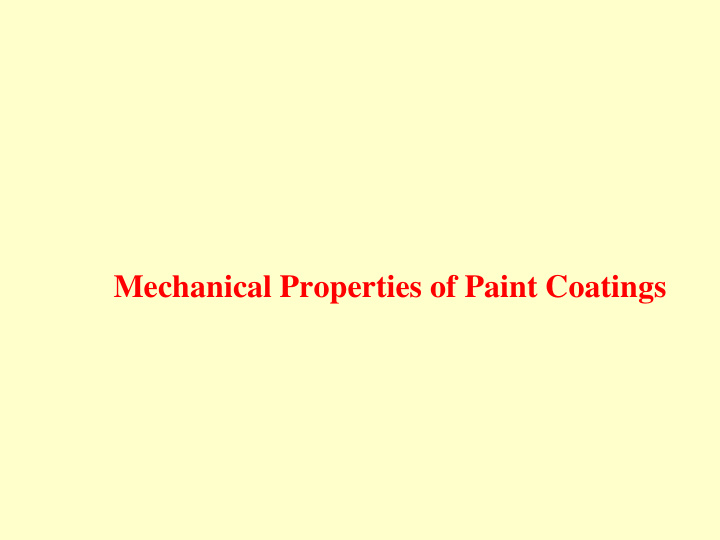



Mechanical Properties of Paint Coatings
Hardness Measurement Shore Hardness D • Barcol Hardness • • ASTM D2583 • Fiberglass Aluminum Aluminum Alloys Soft Metals Plastics
Scratch Hardness- (IS 101 - Part 5/Sec 2) BS 3900 Hardness can be defined as resistance to indentation or scratching • The scratching needle is a hardened steel hemispherical tip of 1 mm dia. • Clamp the panel on the DC circuit panel • Place weights on the holder above the needle • Start the motor to make a scratch on the coating • Observed the scratch for penetration upto the substrate • Failure of the coating is indicated by deflection in the current needle due to completion of the circuit.
Impact Testing ASTM 2794
Abrasion Resistance
Flexibility – Conical Mendral (ASTM D552)
• Tape Test (ASTM D3359) Adhesion Test • Pulloff Adhesion ( BS 4624)
Pull off Test ASTM 4521
Tensile Properties ASTM E8 / D 638 • UTS • YS ( 0.2% Proof Stress) • % Elongation • Modulus of Elasticity • Composite Panel • Skin
HOLIDAY DETECTOR • PINHOLES IN COATINGS • INVISIBLE TO NAKED EYES • DETECTOR COUNTS PINHOLES AND SOUNDS ALARM • ALLOWS INSTANT REPAIR OF PINHOLES
Working Principle electrically conductive rubber electrode paint coating metal substrate
Holiday Detector
Outside-tube testing Large diameters: Especially suitable for large diameters, the ringelectrode enables reliable testing of the complete tube in one or two operations only.
• HOLIDAY DETECTOR • NEW MODEL POROTEST7 DIGITAL • LATEST TECHNOLOGY
ASTM G-62 Stanadrd Prcatice for Holiday Detection in Pipeline Coatings • If the coating thickness is less than 1.016mm then V ( test Voltage) = M (T c ) ½ Where M = 3294 if T c is in mm T c = Coating thickness • If the coating thickness is more than 1.016 mm then V ( test Voltage) = K (T c ) ½ Where K = 7843 if T c is in mm
ASTM D5162 Holiday Testing of Non conductive protective coating on Metallic Substrate Inspection Voltage (KV) Thickness (mils) Thickness (mm) 8-12 0.20-0.31 1.5 13-18 0.32-0.46 2.0 0.47 – 0.77 19-30 2.5 0.78 – 1.03 31-40 4.0 1.04 – 1.54 41-60 5.0 1.55 – 2.04 61-80 7.5 81-100 2.05- 2.55 10.0 2.56 – 3.19 101-125 12.0 3.20 – 4.07 126-160 15.0 4.08 – 5.09 161-200 20.0 201-250 5.10- 6.35 25.0
Chemical Resistance Properties
Humidity Test ASTM – D2247
Immersion Tests • Immersion in various solutions for • 72 hours • 7 days • 1 month • Change in appearance, Blisters, change in dimensions, weight
Salt Spary Test ASTM – B117 • Resistance to corrosion • Blistering ASTM D714 ( Size & Density) • Delamination • Creeping of defects
Accelerated Weathering ASTM G-53-96 Resistance to • Sunlight • Chalking • Cracking
GLOSS The relative luminous reflectance factor of a specimen or the shiny appearance of the coating is GLOSS . Significance • Gloss increases as the PVC of the product decreases • Primers have lower gloss levels than topcoats • Gloss levels increases as the fineness of grind of the product increases • Higher DFT will give higher gloss reading
60 Degree Gloss Measurement Reflected Light Incident Light 60 • GLOSS VALUES are not percentages, the numerical scale is based on highly polished black glass = 100 (or a perfect mirror surface = 1000) • GLOSS RETENTION VALUES are percentages because they are ratios of gloss values
GLOSS Gloss - (ASTM D 523) • Glossometer with various angular geometry are available i.e. 20 / 60 / 85 Deg. • Incidence angle and viewing angle are same for a particular geometry • Calibrate the glossometer on the black tile with specified gloss level. Gloss levels are different for different angles • Place the glossometer on the coated panel • Measure the values at various locations and calculate the mean / range.
GLOSS RANGES (IS :101 PART-4 / SECTION – 4) GLOSS – R FINISH 0 – 10 MATT 11 – 20 EGG SHELL 21 – 40 SATIN 41 – 70 SEMI GLOSS GLOSSY > 70 NOTE : • FOR HIGH GLOSS USE 20 0 HEAD GLOSSOMETER • FOR LOW GLOSS USE 85 0 HEAD GLOSSOMETER
Colour Retention & Gloss Retention Measurement Portable Spectrometer Software for measuring Colour Retention and Gloss
Colour Retention Results
Cathodic Disbondment Test ASTM G-8 -96 Resistance to disbondment Due to cathodic reaction At the defect
Permeability ASTM D 1653 Time in Days
THANK YOU
Recommend
More recommend